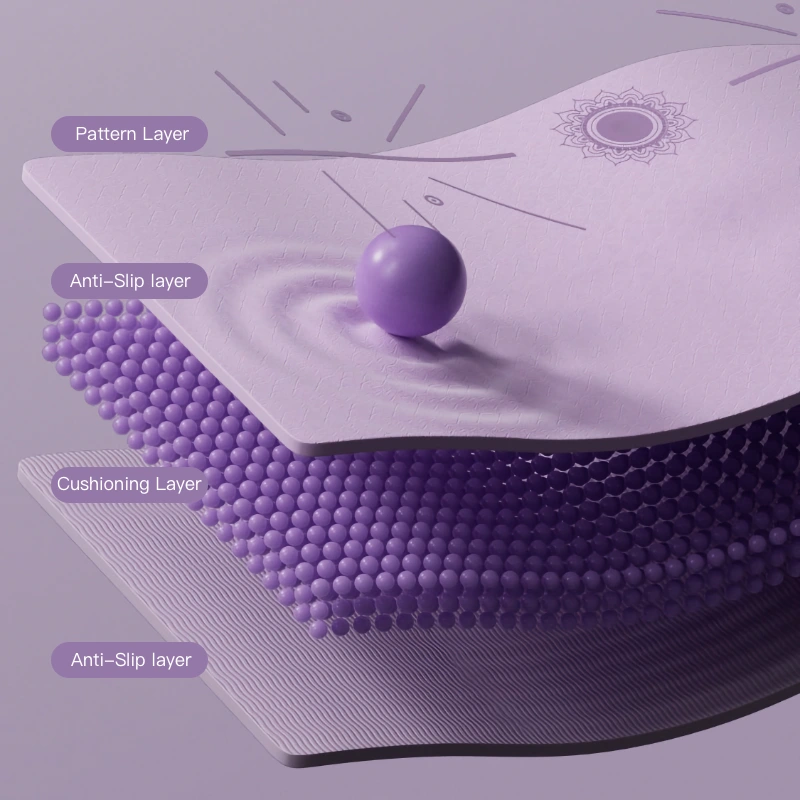Yoga practitioners understand the importance of a reliable and comfortable yoga mat. With the market offering various options, choosing the right mat can be challenging. Thermoplastic Elastomer (TPE) yoga mats have emerged as a superior choice, standing out due to their premium quality and numerous benefits over Ethylene Vinyl Acetate (EVA) mats. This article delves into the science behind TPE, offers a detailed comparison between TPE and EVA, and explores how TPE mats can significantly enhance your yoga experience.
The Science Behind TPE: What Makes It Superior?
Thermoplastic Elastomer (TPE) is a modern material that combines the best properties of rubber and plastic. This unique composition offers several advantages:
- Eco-Friendly: TPE is a recyclable material, making it an environmentally conscious choice. Unlike traditional PVC mats, TPE mats do not release harmful chemicals during production or disposal.
- Durability: TPE mats are known for their long-lasting nature. They maintain their shape and integrity over time, even with frequent use.
- Non-Toxic: Free from latex, PVC, and other harmful chemicals, TPE mats are safe for all users, including those with sensitive skin.
- Lightweight and Portable: Despite their durability, TPE mats are lightweight, making them easy to carry to and from your yoga sessions.
- Closed-Cell Structure: This feature ensures that TPE mats are resistant to moisture and bacteria, promoting hygiene and easy maintenance.
Comparing TPE and EVA: A Detailed Analysis
When choosing a yoga mat, it’s crucial to understand the differences between TPE and EVA materials. Here is a comprehensive comparison:
Comfort and Support
- TPE Mats: Known for their excellent cushioning, TPE mats provide superior support for joints and pressure points. This cushioning effect is especially beneficial for poses that require balance and stability.
- EVA Mats: While EVA mats offer decent cushioning, they tend to be less supportive than TPE mats. Over time, EVA mats may compress, reducing their effectiveness.
Durability
- TPE Mats: Highly durable, TPE mats resist wear and tear, maintaining their performance over time. They are less likely to crack or tear, even with intensive use.
- EVA Mats: EVA mats can degrade faster, particularly with regular use. They are more prone to deformation and loss of cushioning.
Hygiene
- TPE Mats: The closed-cell structure of TPE mats prevents moisture absorption, making them resistant to bacteria and mold. This feature ensures that your mat stays clean and odor-free.
- EVA Mats: EVA mats can absorb sweat and moisture, creating a breeding ground for bacteria and odors. Regular cleaning is necessary to maintain hygiene.
Eco-Friendliness
- TPE Mats: Being recyclable, TPE mats are an environmentally friendly option. Their production process is also less harmful to the environment.
- EVA Mats: EVA mats are not as eco-friendly, as they are less recyclable and often end up in landfills.
How TPE Mats Enhance Your Yoga Experience
Using a TPE yoga mat can significantly enhance your yoga practice. Here’s how:
Improved Comfort and Stability
TPE mats provide exceptional cushioning and support, which can help reduce strain on your joints and improve your overall stability. This allows you to hold poses longer and with better alignment, enhancing the effectiveness of your practice.
Enhanced Grip
The superior grip of TPE mats ensures that you maintain your poses without slipping, even during intense sessions. This is crucial for performing advanced poses that require a strong and steady foundation.
Better Hygiene
With their moisture-resistant properties, TPE mats stay cleaner for longer, reducing the risk of infections and skin irritations. This promotes a healthier and more pleasant yoga practice.
Environmental Responsibility
Choosing a TPE mat reflects your commitment to the environment. By opting for a recyclable and non-toxic product, you contribute to reducing pollution and promoting sustainability.
TPE yoga mats offer a multitude of benefits that can elevate your yoga practice. From their eco-friendly composition and superior durability to their exceptional comfort and hygiene, TPE mats are a wise investment for any yoga enthusiast. By choosing a TPE mat, you not only enhance your practice but also support a healthier planet.
Explore, customize, purchase, and wholesale TPE Yoga Mats products.
FAQ
1. What is TPE?
Thermoplastic Elastomer (TPE) is a modern material that combines the best properties of rubber and plastic. It is known for being eco-friendly, durable, non-toxic, and lightweight.
2. Why are TPE yoga mats considered superior to EVA mats?
TPE yoga mats offer superior cushioning, durability, hygiene, and eco-friendliness compared to EVA mats. They provide better support for joints, resist wear and tear, and are easier to keep clean.
3. Are TPE yoga mats eco-friendly?
Yes, TPE yoga mats are recyclable and have a lower environmental impact compared to traditional PVC mats. Their production process is also less harmful to the environment.
4. How do TPE mats enhance my yoga practice?
TPE mats offer excellent cushioning and support, improved grip, better hygiene, and contribute to environmental sustainability, all of which enhance your overall yoga experience.
5. How do I maintain a TPE yoga mat?
TPE yoga mats are easy to maintain due to their closed-cell structure. Simply wipe them down with a damp cloth and mild detergent after each use to keep them clean and odor-free.
